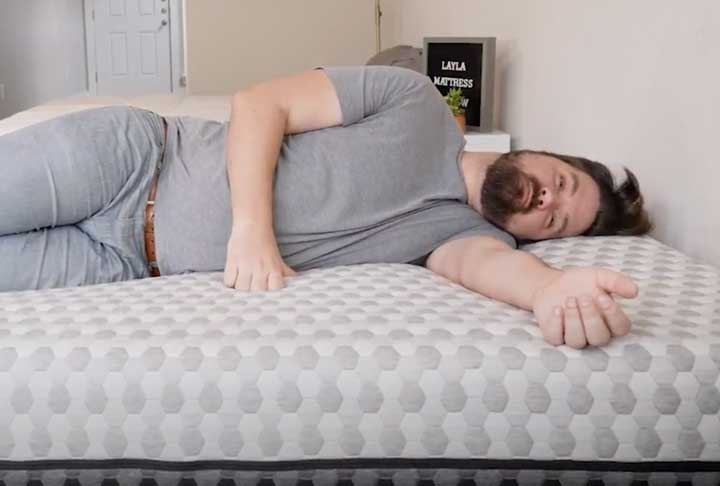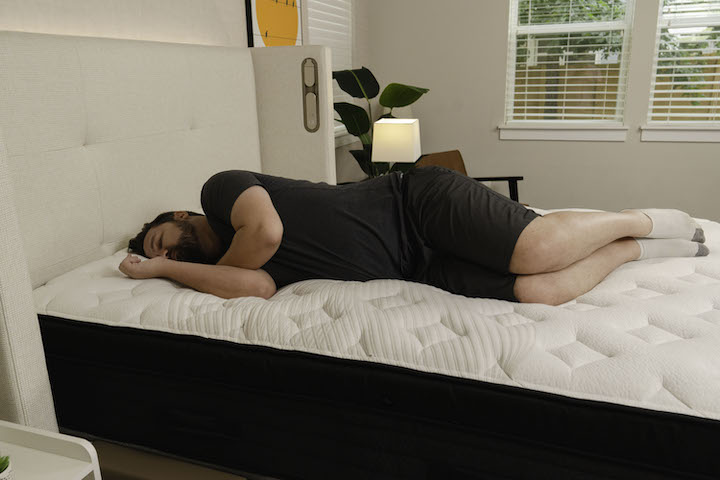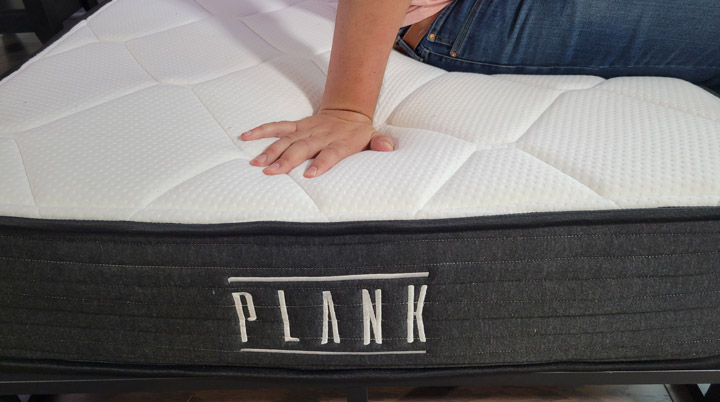If you’re shopping for a new mattress, you’re likely familiar with firmness ratings. But you might be surprised to know that a firmness rating is really more of an educated guess than anything else, because mattress firmness is subjective.
Individual body type, weight and personal preferences all influence how soft or firm a mattress feels, which means the same mattress can feel different from one person to the next.
The good news is that understanding a bit about mattress firmness, including how it’s typically measured in the mattress industry, is the best way to find an appropriate firmness for your needs. In this mattress firmness guide, I’ll cover everything you need to know.
The Mattress Firmness Scale
When a mattress company refers to firmness, it’s a description of how the mattress feels when you lie on it. Some mattresses are soft and yielding — you feel yourself sinking into the mattress. Others are firmer, giving you the sensation that you’re resting on top of the mattress. All of these observations relate to the mattress’ firmness. To help consumers understand what they can expect, especially for a mattress that can’t be tested in person before purchase, mattress companies use a firmness scale.
The mattress firmness scale is rated from 1 to 10, with 1 being the softest and 10 being the firmest. Most mattresses fall into the medium-firm range, which is a 6.5 on the scale.

Soft
Most soft and plush mattresses are somewhere between 3/10 and 6/10 on the firmness scale, thanks to features like soft foams and cushioning pillow tops.
Soft mattresses are generally known for their cushy sensation, with deep sinkage, close contouring, and pressure relief. The Helix Sunset comes in at 5.5/10 on the firmness scale. The Layla Memory Foam Mattress, a flippable model, has a soft side rated at a 6/10, as well as a firm side rated at 8/10. See our list of the best soft mattresses for more options.
It’s rare to find a mattress that’s rated lower than about a 3/10 on the firmness scale. At that point, the softness becomes unsupportive.
Who It’s Right For:
- Lightweight people. Without sufficient weight to sink into a mattress, lightweight sleepers often perceive mattresses to feel firmer than advertised. A soft mattress can be a good option for more comfort.
- Side sleepers. People who sleep on their sides need more softness for proper cushioning around their hips and shoulders, so a soft mattress can be a good fit.
- People who need pressure relief. Soft mattresses that contour closely around the body’s curves distribute body weight well, which can reduce pressure in areas prone to pain, like the low back, hips, and shoulders.

Medium-Firm
Medium-firm mattresses accommodate a wide range of sleepers, so they can be a good compromise for couples who have different preferences. Most medium-firm mattresses are right at 6.5/10 on the firmness scale. You can also go slightly higher for a medium-firm mattress, or a 7/10 on the scale.
This mattress firmness has a middle-of-the-road feel that’s often the result of softer foam layers stacked over supportive bases. It creates a balanced sensation with both support and pressure relief. There may be a touch of sinkage in areas of deeper compression, but overall, this firmness level keeps the body feeling lifted.
Because they work so well for different sleepers, there are a lot of medium-firm mattresses on the market in both hybrid and all-foam constructions. The Helix Midnight, Nolah Evolution and Birch are good examples of different medium-firm mattresses.
Who it’s Right For:
- Average-weight back and side sleepers. Both back and side sleepers in average weight ranges (between 130 and 230 lbs) should find a good balance of spinal support and pressure relief on a medium-firm mattress. These beds also work well for combination sleepers who switch between these positions.
- Some back sleepers who weigh more than 230 lbs. Heavier back sleepers usually get ample support from medium-firm mattresses.
- People looking for a balance of comfort and support. If you prefer a middle-of-the-road feel that’s equally comfortable and supportive, medium-firm is ideal.

Firm
Mattresses rated 7/10 or above are considered firm. It’s unusual to find a mattress rated at 10/10. Even the Plank Firm, the firmest mattress we’ve tested, is rated a 9/10 on its firm side.
Firm mattresses have little to no sinkage, and they create the sensation that every part of the body in contact with the mattress is being evenly pushed up.
The Helix Dawn, the WinkBed (“Firmer” model) and Bear Original are popular firm mattresses. See more picks in our list of the best firm mattresses.
Who it’s Right For:
- Stomach sleepers. To prevent back pain, stomach sleepers need a mattress that keeps their hips properly elevated. Firm mattresses often do the trick.
- Many people who weigh more than 230 lbs. Heavier people often sink into mattresses more, which can make them feel softer. For this reason, firm mattresses often offer the right amount of support for people who weigh more than 230 lbs.

What is the Best Firmness for a Mattress?
Again, mattress firmness is subjective, which means there’s no single best firmness that applies to everyone. The best mattress firmness depends on your body type, sleeping position, and personal preferences.
Back sleepers, for example, need a mattress that’s firm enough to support them properly but soft enough to avoid tension in the lumbar zone. Medium-firm mattresses tend to be the best options because there’s enough support to keep the spine neutral, but enough softness to help relieve pressure and pain.
For side sleepers, soft mattresses can offer pressure relief at the shoulders, hips, and lower back. Stomach sleepers, on the other hand, need firm mattresses that lift and support the hips. Otherwise, the spine is pulled out of alignment, leading to back pain. Most stomach sleepers do well on a mattress with a firmness rating of 7/10 or higher. There are many mattresses that have firmness to help not only feel supported but also help to keep the spine aligned such as the ones featured on our best mattresses for back pain review.
Is Firmness the Same as Support?
While the terms “firmness” and “support” are often used interchangeably when discussing the properties of a mattress, they aren’t the same thing. Firmness, as I’ve covered, describes how the mattress feels when you lie on it. Support refers to how well the mattress helps you maintain the proper spinal alignment.
How to Find the Right Mattress Firmness
Choosing the right mattress firmness is really a matter of considering yourself and your own needs. Deciding between firm vs soft mattresses boils down to two key factors.
Sleeping Position
This is the most important consideration. How you prefer to sleep dictates the most appropriate mattress firmness. Back sleepers generally do well in the 6/10 to 7/10 range, while stomach sleepers should go firmer — a 7/10 or above. Side sleepers should go softer, with mattresses that score between a 5/10 and 6.5/10.
Weight
Your body weight affects how soft or firm a mattress feels. Two back sleepers in different weight categories — light and heavy, for example — will perceive the same mattress to feel firmer or softer. Factoring for your body weight can steer you toward a mattress that will suit your sleeping position, regardless of how the manufacturer ranks its firmness score. If you’re over 230 lbs and looking for a new mattress that will give you the support you need, consider our best mattress for heavy people.
When in Doubt, Opt for Medium-Firm
If you still aren’t sure about the most appropriate mattress firmness for your needs, medium-firm is usually a safe bet. They’re called “universally comfortable” for a reason — medium-firm mattresses appeal to the widest range of body types and sleep styles.
FAQs
What level of firmness should my mattress be?
The right firmness for your mattress should be based on your body type and sleep style. Back sleepers usually benefit from medium-firm mattresses, because this firmness level helps keep the spine aligned. Stomach sleepers often need something on the firmer side to ensure the hips stay properly elevated. Side sleepers do best with a softer mattress that cradles the hips and shoulders. Keep in mind that heavier sleepers tend to perceive mattresses as softer than advertised, while lighter sleepers often find them firmer.
What is the most popular mattress firmness?
The most popular mattress firmness is around 6.5/10, or medium-firm. This firmness level balances support with pressure relief and can accommodate a wide range of body types and sleeping positions.
How do I know what mattress firmness I like?
The right mattress firmness will keep your body comfortable and your spine aligned, so think about your body type and your sleeping position to zero in on an appropriate firmness. While many people think that soft mattresses are the best option, because “soft” indicates a certain level of cushiness, it’s not the best fit for certain body types and sleeping positions. Don’t choose a firmness level based on what you think you’ll like — use your body type and sleep position as a guide.

